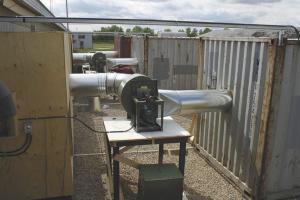"Water Wall" Filter Cuts Swine Smell
 ✖  |
A wall covered with water can cut swine ammonia levels, odor and dust significantly. A biotrickling filtration system developed at the Prairie Swine Centre (PSC), Saskatoon, Sask., cut ammonia levels by 77 percent, dust by 92 percent and odor levels by 75 percent, according to PSC researchers.
“The water recirculated from sumps over the top of walls and trickled back down,” explains Bernardo Predicala, lead researcher, PSC.
Microbes that grew on the wet wall and the wall itself carried out the filtration. As the stale barn air passed through both, contaminates were removed from the air and collected in the water.
Each air treatment unit (ATU) consisted of 2 vertical walls of porous plastic and a sprinkler system. Units were housed in standard 8 by 8 by 20-ft. long shipping containers.
Predicala says anyone could put a similar system together from commonly available materials...if they had the right design. Each ATU has to be configured for the design of the building, the number of pigs and the amount of contaminate to be removed. Predicala points out that ammonia levels in the test barn varied considerably depending on the age and size of the animals.
“There is no one producing them commercially for use with swine barns; however, there are similar units being used in other industries,” he says. “A design isn’t something you can just pull off a shelf. If someone wanted to work with an engineer to build one, we could provide guidance.”
The tests were done in 2012, and the research was completed in 2013. The next step is technology transfer as the PSC gets the word out across Canada. Future research may include evaluating the wastewater for available nutrients.
Predicala explains that each ATU used about 132 gal. of water a day due to evaporation and periodic replacement. The replacement was necessary as the water became increasingly saturated with contaminants, including ammonia. Fresh water was substituted to protect microbial growth and function.
“One of the considerations is whether the captured ammonia will remain in liquid form. Another is can it be used for fertilizer,” says Predicala. “We made calculations of how much nitrogen is captured so there is a value. It’s not waste to be treated and disposed of.”
Contact: FARM SHOW Followup, Prairie Swine Centre,
Box 21057, 2105 - 8th St. East, Saskatoon, Sask., Canada
S7H 5N9 (ph 306 373-9922; www.prairieswine.com).

Click here to view page story appeared in
Click here to read entire issue
Water Wall Filter Cuts Swine Smell HOG EQUIPMENT & IDEAS A wall covered with water can cut swine ammonia levels odor and dust significantly A biotrickling filtration system developed at the Prairie Swine Centre PSC Saskatoon Sask cut ammonia levels by 77 percent dust by 92 percent and odor levels by 75 percent according to PSC researchers “The water recirculated from sumps over the top of walls and trickled back down ” explains Bernardo Predicala lead researcher PSC Microbes that grew on the wet wall and the wall itself carried out the filtration As the stale barn air passed through both contaminates were removed from the air and collected in the water Each air treatment unit ATU consisted of 2 vertical walls of porous plastic and a sprinkler system Units were housed in standard 8 by 8 by 20-ft long shipping containers Predicala says anyone could put a similar system together from commonly available materials if they had the right design Each ATU has to be configured for the design of the building the number of pigs and the amount of contaminate to be removed Predicala points out that ammonia levels in the test barn varied considerably depending on the age and size of the animals “There is no one producing them commercially for use with swine barns; however there are similar units being used in other industries ” he says “A design isn’t something you can just pull off a shelf If someone wanted to work with an engineer to build one we could provide guidance ” The tests were done in 2012 and the research was completed in 2013 The next step is technology transfer as the PSC gets the word out across Canada Future research may include evaluating the wastewater for available nutrients Predicala explains that each ATU used about 132 gal of water a day due to evaporation and periodic replacement The replacement was necessary as the water became increasingly saturated with contaminants including ammonia Fresh water was substituted to protect microbial growth and function “One of the considerations is whether the captured ammonia will remain in liquid form Another is can it be used for fertilizer ” says Predicala “We made calculations of how much nitrogen is captured so there is a value It’s not waste to be treated and disposed of ” Contact: FARM SHOW Followup Prairie Swine Centre
Box 21057 2105 - 8th St East Saskatoon Sask Canada
S7H 5N9 ph 306 373-9922; www prairieswine com
To read the rest of this story, download this issue below or click
here to register with your account number.







